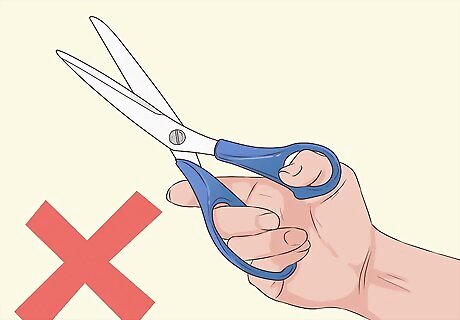
views
Using an Electric Ear Hair Trimmer

Clean your ears with a saltwater solution. Before trimming your ear hair, make sure to clean wax or other debris out of your ears. Mix a saltwater solution using a ratio of one teaspoon of salt per ½ cup (4 oz.) of water. Dip a clean Q-tip into the saltwater and gently clean the immediate ear area (exterior to the ear canal) and the crevices at the top of the outer ear.

Purchase an ear hair trimmer. To avoid cheap, ineffective trimmers as well as needlessly overpriced ones, opt for a mid-range model of ear hair trimmer (approximately $30-$50) . Look for a model with a rotary blade system and skin guard, which will prevent the blades from cutting your ears while you trim. If you are a frequent traveler, opt for a more lightweight trimmer that comes with a handy travel case. Most models of ear hair trimmers are battery-operated, so consider investing in rechargeable alkaline batteries and a charger.

Set up in a well-lit area. Choose a room with bright lighting (e.g. the bathroom) to trim your ear hair in. If possible, use a magnified mirror to see the ear hair that you want to trim as clearly as possible. While your fine ear hair might be invisible to you from some angles, it may be visible to people around you!

Gently trim your ear hair. Make sure your ear hair trimmer fits comfortably into your ear canal and make sure that you don’t have to apply any force to insert it. Turn the trimmer on and gently move it over your ear hair to remove it. Stop and check your progress every minute or two to decide if you like the results.
Getting Laser Hair Removal

Research clinics that offer laser hair removal. Laser hair removal uses a laser beam to target and destroys dark hair follicles, leaving your skin nearly hairless. Look online for popular laser hair removal services in your area and look for reviews of the clinics offering them. Call to ask about possible treatments for removing your ear hair, and get pricing information so you can comparison-shop between clinics. Ask clinics what financing options they offer (e.g. monthly payments). Make sure that the laser hair removal is done by an experienced doctor with a relevant specialty, like dermatology or cosmetic surgery.

Set aside time for treatments. Because laser hair removal works in sequence with your hair growth cycle, a specific schedule of treatments will have to be established for effective hair removal. Make time for 4-6 sessions, held about a month apart, which is the standard procedure for most patients. Note that given the small area that ear hair covers, ear hair removal sessions should last only a short time.

Protect your skin. To protect your skin and ensure the results of your laser treatments, avoid the sun for approximately 6 weeks before your first appointment. Getting a lot of sun can greatly increase the risk of skin lightening during treatment. Keep your ears protected by wearing a wide brimmed hat outdoors before and during your hair removal sessions, or by applying sunscreen with a high SPF to your ears.
Avoiding Bad Trimming Methods

Opt against using scissors. Unless you are left with no other options, avoid using scissors to cut ear hair. Ear canals are very sensitive and the blades of a pair of scissors can easily damage them irreversibly. If you do use scissors, choose small, precise scissors and trim your ear hair slowly in a well-lit area.

Don’t use tweezers. Avoid tweezing ear hair, which may cause damage to your sensitive ear canals. Tweezing can cause inflammation or lesions, which could lead to an infection. This method of hair removal is also very painful and time-consuming, so you should avoid it as a regular grooming ritual.

Never use hair removal creams. While depilatory creams may seem like an easy way to remove hair from your ears, this method of hair removal should be avoided. The strong chemicals in hair removal creams can cause permanent damage to sensitive areas like the ears, eyes, and nose. Even milder depilatory creams (e.g. for underarms, upper lip, and bikini line) should not be used near the ears.



















Comments
0 comment